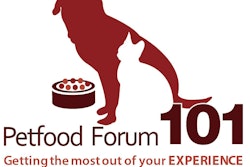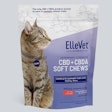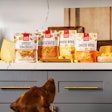
Pet food industry professionals learned how to meet consumer demands for clean label pet foods at Petfood Innovation Workshop on April 29 in Kansas City, Missouri, the day before Petfood Forum 2019.
When dog, cat and other pet owners read the ingredient panels of pet food labels, some find complex terms, such as sodium chloride and acetic acid, worrisome in comparison to straightforward names like table salt and vinegar. Likewise, parsimonious pet food formulation are preferred to those containing long inventories of syllable soup.
Clean label pet food marketing attempts to assuage people’s fear of Latin prefixes, chemical equations and long lists. While there is no single definition, clean label pet foods tend to use short, simple recipes with few synthetic vitamins, preservatives and other artificial ingredients.
Petfood Innovation Workshop attendees visited stations presented by ingredient suppliers, equipment manufacturers, food safety laboratories and others. Each station taught a different aspect of how pet food companies can meet dog, cat and other pet food owners’ demands for clean label pet food.
1. Protect brand equity through clean label marketing
Presenter: DSM
As the name implies, clean label pet food depends on the marketing claims made on its packaging. Certain keywords stand out to consumers looking for clean labels, particularly those that state what isn’t in the products. DSM representatives challenged workshop attendees to form teams and brainstorm the next clean label pet food brand. To convey their product’s key attributes, attendees selected phrases such as “local family farm” and “no Frankenfoods” to display on pet food packages, along with graphic representations of the nutritional constituents of the food.
“Add more detail for curious consumers,” said Jeff Alix, global marketing manager pet nutrition at DSM Nutritional Products.
DSM’s representatives recommended other examples of marketing claims to use on clean label and other on-trend pet foods included:
- Environmental concerns - seafood sustainability, carbon footprint, greenhouse gases
- Free-from claims - no-GMO, no artificial, no allergens,
- Simple and clear - how much is in there, single meat source
- Transparent - source of raw materials, terms explained
DSM provides producers of nutritional pet food products with a range of functional ingredients.
2. Clean label pet food packaging sustainability matters
Presenter: TC Transcontinental
The clean label movement doesn’t end with the label, necessarily. The packaging itself can become part of a pet food brands’ clean label statement, since environmental sustainability is the ultimate cleanliness.
Dave Long, vice president of market development for TC Transcontinental Packaging, discussed the current challenges and future promise of sustainable flexible containers for pet food.
“We have some science to do to make packaging more recyclable,” he said.
Humanization and premiumization of pet food resulted in higher quality products that required better protective packaging, Long said, especially when clean label pet foods call for limited use of preservatives. While improved packages keep bacteria and fungus out of pet food, the bags themselves also tend to resist decomposers.
Recycling many pet food bags proves impossible because of plastic films bonded to the paper to provide grease and moisture barriers. Long discussed current prototypes and research that may solve this dilemma.
Recycling is only one way of dealing with waste though, and other options may be preferable, he said. Reducing, reusing and similar options often prove better for the environment.
3. Learn to verify clean label, pet food ingredients
Presenter: Bureau Veritas
Clean labels depend on the absence or presence of certain substances, but how can anyone really know what is in that product? Bureau Veritas asked participants to consider what analytical tests could determine if a pet food or treat lived up to clean label standards. Mixed groups of formulators, marketers and others evaluated ingredient lists to consider if laboratory tests could verify the clean label and the ingredients on the label.
Bureau Veritas provides laboratory services and analytical solutions. The company’s food science and safety services division specializes in microbiology, chemistry and residue testing of food samples. Bureau Veritas has approximately 7,500 employees in over 140 facilities across North America processing over 2.5 million samples a year.
4. Clean label pet food Deal or No Deal
Presenter: Ingredion Corporation
Ingredion Corporation representatives played Deal or No Deal to test participants’ knowledge of clean label pet foods. Players answered questions about the consumer demands and demographics that drive the clean label trend. For example, players answered questions about how millennials are driving the demand for clean label pet food. Millennials, the largest pet-owning demographic group in the U.S., increasingly live in apartments in urban areas. This tendency has led to more small dogs among that generation than for Gen X or baby boomers. Although millennials subsequently may buy less pet food, they also may be more likely to pay for superpremium, clean label pet food.
Ingredion’s portfolio of ingredients address pet food makers needs for clean label, health and nutrition, grain-free and more.
















